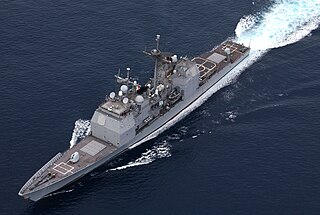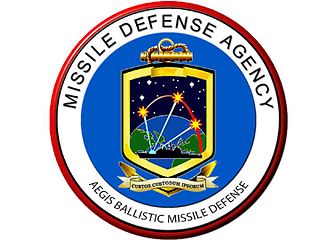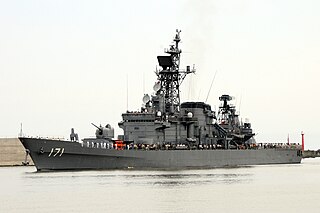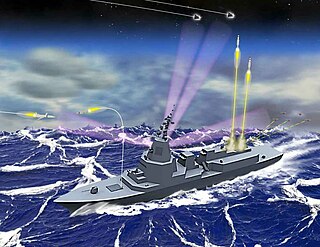
The Aegis Combat System is an American integrated naval weapons system, which uses computers and radars to track and guide weapons to destroy enemy targets. It was developed by the Missile and Surface Radar Division of RCA, and it is now produced by Lockheed Martin.

The Aegis ballistic missile defense system, also known as Sea-Based Midcourse, is a Missile Defense Agency program under the United States Department of Defense developed to provide missile defense against short and intermediate-range ballistic missiles. The program is part of the United States national missile defense strategy and European NATO missile defense system.

The Kongō class of guided-missile destroyers in the Japan Maritime Self-Defense Force are equipped with the Aegis Combat System, and is the first of few ship classes outside the United States to have that capability. Following a decision made in December 2003, Japan is upgrading their Kongo-class destroyers with Aegis Ballistic Missile Defense System. The upgrade involves a series of installations and flight tests to take place from 2007 to 2010. JS Kongo was the first ship to have the BMD upgrade installed.

The Japan Maritime Self-Defense Force, abbreviated JMSDF, also simply known as the Japanese Navy, is the maritime warfare branch of the Japan Self-Defense Forces, tasked with the naval defense of Japan. The JMSDF was formed following the dissolution of the Imperial Japanese Navy (IJN) after World War II. The JMSDF has a fleet of 154 ships, 346 aircraft and 50,800 personnel.

The Atago class of guided-missile destroyers in the Japan Maritime Self-Defense Force is a modified version of the Kongō class equipped with the Aegis Combat System.

The Murasame-class destroyer is a class of destroyers, serving with the Japan Maritime Self-Defense Force (JMSDF). This is the first class of the second-generation general-purpose destroyers of the JMSDF.

JS Kirishima (DDG-174) is a Kongō-class guided missile destroyer in the Japan Maritime Self-Defense Force (JMSDF). Kirishima was named for Mount Kirishima. She was laid down by Mitsubishi Heavy Industries in Nagasaki, Nagasaki on 7 April 1992, and was launched on 19 August 1993.

JS Myōkō (DDG-175) is a Kongō-class guided missile destroyer in the Japan Maritime Self-Defense Force (JMSDF). Myōkō was named after Mount Myōkō.

JS Chōkai (DDG-176) is a Kongō-class guided missile destroyer in the Japan Maritime Self-Defense Force (JMSDF). Chōkai was named after Mount Chōkai. She was laid down by IHI Corporation in Tokyo on 29 May 1995 and was launched on 27 August 1996. Commissioning happened on March 20, 1998.

JS Atago (DDG-177), あたご, is the lead ship of her class of guided missile destroyer in the Japan Maritime Self-Defense Force (JMSDF). She was named after Mount Atago. She was laid down by Mitsubishi Heavy Industries in Nagasaki on April 5, 2004. Launching ceremony happened on August 24, 2005 and she was commissioned on March 15, 2007.

JS Ashigara (DDG-178) is an Atago-class guided missile destroyer in the Japan Maritime Self-Defense Force (JMSDF). Ashigara was named for Mount Ashigara, and is the first Japanese ship to bear the prefix JS instead of JDS.

JS Kurama (DDH-144) was the second ship of the Shirane-class destroyer in service with the Japan Maritime Self-Defense Force (JMSDF).

The Maya class of guided-missile destroyers in the Japan Maritime Self-Defense Force is a modified version of the Atago class, with an updated Aegis Combat System and electric propulsion system. Maya was commissioned on March 19, 2020. Haguro was commissioned on March 19, 2021.

JS Maya (DDG-179) is the lead ship of her class of guided missile destroyer in the Japan Maritime Self-Defense Force (JMSDF). She was named after Mount Maya and shares her name with a World War II heavy cruiser.

JS Haguro (DDG-180) is the second Maya-class guided missile destroyer in the Japan Maritime Self-Defense Force (JMSDF). She was named after Mount Haguro, one of Three Mountains of Dewa in Yamagata Prefecture.

JS Hatakaze (DDG-171/TV-3520) is a Hatakaze-class guided missile destroyer built for the Japan Maritime Self-Defense Force (JMSDF). Hatakaze was the first vessel completed of her class. She was the first JMSDF vessel to use gas turbine propulsion.

JDS Tachikaze (DDG-168) is the lead ship of the Tachikaze-class destroyer built for the Japan Maritime Self-Defense Force (JMSDF).

JDS Asakaze (DDG-169) is the second ship of the Tachikaze-class destroyer built for the Japan Maritime Self-Defense Force (JMSDF).

JS Sawakaze (DDG-170) is the third ship of the Tachikaze-class destroyer built for the Japan Maritime Self-Defense Force (JMSDF).

Aegis system equipped vessels (ASEV) or (Japanese: イージス・システム搭載艦) are a proposed pair of ballistic missile defense (BMD) warships to be operated by the Japanese Maritime Self-Defense Force (JMSDF) as dedicated sea-based BMD platforms, serving as an alternative to Japan's now-cancelled land-based Aegis Ashore BMD system.

























